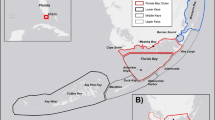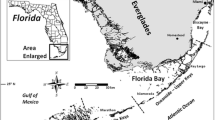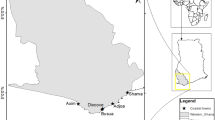Abstract
Local ecological knowledge (LEK) can be a valuable approach to fill in knowledge gaps in data-limited systems. Recent research has aimed to make LEK more quantitative-a key step to better integration of LEK into fisheries science and management. Here, we used LEK to a) quantify changes in bonefishing quality over time in South Florida as perceived by members of the flats fishery, and b) demonstrate the applicability of a life history calendar approach to LEK quantitative data collection. In an online survey, we asked anglers and guides to quantitatively evaluate changes in the quality of bonefishing, as a function of bonefish number and size, over the past 40 years in Biscayne Bay, Florida Bay, and the Florida Keys. Results showed a perceived 56% decrease in bonefish number, and a 45% decline in bonefish size since 1975. Respondents reported a decline in bonefish numbers that preceded the decline in size, with numbers starting to decline over 1985–1995, and size by 2005. In terms of the pattern of decline, bonefish number showed a heterogeneous pattern, with a slower rate of decline in 1985–2005 and an accelerated rate over 2005–2010, whereas the size decline was homogenous over 2000–2015. Overall, the study provides additional resolution, spatial coverage, and support to the pattern of bonefish population decline in the region, illustrating the utility of quantitative approaches to LEK data collection, and highlighting the value of integrating multiple knowledge sources to fully characterize ecological patterns.





Similar content being viewed by others
References
Adams AJ (2017) Guidelines for evaluating the suitability of catch and release fisheries: lessons learned from Caribbean flats fisheries. Fish Res 186:672–680. https://doi.org/10.1016/j.fishres.2016.09.027
Adams AJ, Cooke SJ (2015) Advancing the science and management of flats fisheries for bonefish, tarpon, and permit. Environ Biol Fish 98:2123–2131. https://doi.org/10.1007/s10641-015-0446-9
Adams AJ, Murchie KJ (2015) Recreational fisheries as conservation tools for mangrove habitats. Am Fish Soc Symp 83:43–56
Adams AJ, Horodysky AZ, Mcbride RS et al (2014) Global conservation status and research needs for tarpons (Megalopidae), ladyfishes (Elopidae) and bonefishes (Albulidae). Fish Fish 15:280–311. https://doi.org/10.1111/faf.12017
Ainsworth CH, Pitcher TJ, Rotinsulu C (2008) Evidence of fishery depletions and shifting cognitive baselines in eastern Indonesia. Biol Conserv 141:848–859
Anadon JD, Gimenez A, Ballestar R, Perez I (2009) Evaluation of local ecological knowledge as a method for collecting extensive data on animal abundance. Conserv Biol 23:617–625
Ault JS, Bohnsack JA, Smith SG, Luo J (2005) Towards sustainable multispecies fisheries in the Florida, USA, coral reef ecosystem. Bull Mar Sci 76:595–622
Axinn WG, Pearce LD, Ghimire D (1999) Innovations in life history calendar applications. Soc Sci Res 28:243–264
Aylesworth L, Phoonsawat R, Suvanachai P, Vincent ACJ (2017) Generating spatial data for marine conservation and management. Biodivers Conserv 26:383–399. https://doi.org/10.1007/s10531-016-1248-x
Beaudreau AH, Levin PS (2014) Advancing the use of local ecological knowledge for assessing data-poor species in coastal ecosystems. Ecol Appl 24:244–256. https://doi.org/10.1890/13-0817.1
Belli RF, Shay WL, Stafford FP (2001) Event history calendars and question list surveys: A direct comparison of interviewing methods. Public Opin Q 65:45–74
Bohensky EL, Butler JRA, Davies J (2013) Integrating indigenous ecological knowledge and science in natural resource management: perspectives from Australia. Ecol Soc 18:20
Bojanowski M (2017) Lspline: linear splines with convenient Parametrisations. R package version 1.0–0. https://CRAN.R-project.org/package=lspline
Boucek RE, Rehage JS (2014) Climate extremes drive changes in functional community structure. Glob Chang Biol 20:1821–1831. https://doi.org/10.1111/gcb.12574
Brownscombe JW, AJ Danylchuk, AJ Adams, B Black, R Boucek, M Power, JS Rehage, RO Santos, RW Fisher, B Horn, CR Haak, S Morton, J Hunt, R Ahrens, MS Allen, J Shenker, SJ Cooke. (2018) Bonefish in South Florida: status, threats and research needs. Environ Biol Fish. https://doi.org/10.1007/s10641-018-0820-5
Caddy JF, Gulland JA (1983) Historical patterns of fish stocks. Mar Policy 7:267–278. https://doi.org/10.1016/0308-597X(83)90040-4
Caughley G (1994) Directions in conservation biology. J Anim Ecol 63:215–244 http://www.jstor.org/stable/5542
Cook GA, Heinen JT (2005) On the uncertain costs and tenuous benefits of marine protected areas: a case study of Tortugas ecological reserve, South Florida. Nat Areas J 25:390–396
Danylchuk AJ, Cooke SJ (2011) Engaging the recreational angling community to implement and manage aquatic protected areas. Conserv Biol 25:458–464
Daw TM (2010) Shifting baselines and memory illusions: what should we worry about when inferring trends from resource user interviews? Anim Conserv 13:534–535. https://doi.org/10.1111/j.1469-1795.2010.00418.x
Drescher M, Perera AH, Johnson CJ, Buse LJ, Drew CA, Burgman MA (2013) Toward rigorous use of expert knowledge in ecological research. Ecosphere 4:1–26
Dusek GA, Yurova YV, Ruppel CP (2015) Using social media and targeted snowball sampling to survey a hard-to-reach population: a case study. Int J Doctoral Stud 10:279–299
Fedler A (2013) Economic impact of the Florida keys flats fishery. Report to Bonefish & Tarpon Trust, Key Largo
Fernandez C, Adams AJ (2004) Fly-fishing for bonefish. Stackpole Books
Freedman D, Thornton A, Camburn D, Alwin D, Young-DeMarco L (1988) The life history calendar: a technique for collecting retrospective data. Sociol Methodol 18:37–68
Frezza PE, Clem SE (2015) Using local fishers’ knowledge to characterize historical trends in the Florida bay bonefish population and fishery. Environ Biol Fish 98:2187–2202. https://doi.org/10.1007/s10641-015-0442-0
Gilchrist G, Mallory M, Merkel F (2005) Can local ecological knowledge contribute to wildlife management? Case studies of migratory birds. Ecol Soc 10:20
Glasner T, van der Vaart W, Dijkstra W (2015) Calendar instruments in retrospective web surveys. Field Methods 27:265–283
Grömping U (2006) R package relaimpo: relative importance for linear regression. J Stat Softw 17:139–147. https://doi.org/10.1016/j.foreco.2006.08.245
Hind EJ (2015) A review of the past, the present, and the future of fishers' knowledge research: a challenge to established fisheries science. ICES J Mar Sci 72:341–358. https://doi.org/10.1093/icesjms/fsu169
Hothorn T, Bretz F, Westfall P (2008) Simultaneous inference in general parametric models. Biom J 50:346–363. https://doi.org/10.1002/bimj.200810425
Huntington HP (2000) Using traditional ecological knowledge in science: methods and applications. Ecol Appl 10:1270–1274
Johannes RE, Neis B (2007) The value of anecdote. In: Haggan N, Neis B, Baird IG (eds) Fishers’ knowledge in fisheries science and management. UNESCO Publishing, Paris, pp 35–58
Johannes RE, Freeman MMR, Hamilton RJ (2000) Ignore fishers’ knowledge and miss the boat. Fish Fish 1:257–271
Kroloff EJ, Heinen KN, Braddock JS, Rehage RO, Santos (2018) Understanding the decline of catch-and-release fishery with angler knowledge: a key informant approach applied to South Florida bonefish. Environmental Biology of Fishes https://doi.org/10.1007/s10641-018-0812-5
Laborde S, Imberger J, Toussaint S (2012) Contributions of local knowledge to the physical limnology of Lake Como, Italy. Proc Natl Acad Sci 109:6441–6445. https://doi.org/10.1073/pnas.1113740109
Larkin MF (2011) Assessment of South Florida’s bonefish stock. Dissertation, University of Miami
Larkin MF, Ault JS, Humston R, Luo J (2010) A mail survey to estimate the fishery dynamics of southern Florida’s bonefish charter fleet. Fish Manag Ecol 17:254–261. https://doi.org/10.1111/j.1365-2400.2009.00718.x
Morselli D, Berchtold A, Granell JCS, Berchtold A (2016) On-line life history calendar and sensitive topics: a pilot study. Comput Hum Behav 58:141–149
Papworth SK, Rist J, Coad L, Milner-Gulland EJ (2009) Evidence for shifting baseline syndrome in conservation. Conserv Lett 2:93–100
Pauly D (1995) Anecdotes and the shifting baseline syndrome of fisheries. Trends Ecol Evol 10:430
Planque B, Fromentin JM, Cury P, Drinkwater KF, Jennings S, Perry RI, Kifani S (2010) How does fishing alter marine populations and ecosystems sensitivity to climate? J Mar Syst 79:403–417. https://doi.org/10.1016/j.jmarsys.2008.12.018
Post JR (2013) Resilient recreational fisheries or prone to collapse? A decade of research on the science and management of recreational fisheries. Fish Manag Ecol 20:99–110
Sáenz-Arroyo A, Revollo-Fernández D (2016) Local ecological knowledge concurs with fishing statistics: an example from the abalone fishery in Baja California, Mexico. Mar Policy 71:217–221. https://doi.org/10.1016/j.marpol.2016.06.006
Sáenz-Arroyo A, Roberts CM, Torre J, Cariño-Olvera M, Hawkins JP (2006) The value of evidence about past abundance: marine fauna of the Gulf of California through the eyes of 16th to 19th century travellers. Fish Fish 7:128–146
Santos RO, Rehage JS, Boucek R, Osborne J (2016) Shift in recreational fishing catches as a function of an extreme cold event. Ecosphere 7:e01335. https://doi.org/10.1002/ecs2.1335
Santos RO, Rehage JS, Adams AJ et al (2017) Quantitative assessment of a data-limited recreational bonefish fishery using a time- series of fishing guides reports. PLoS One 12:e0184776. https://doi.org/10.1371/journal.pone.0184776
Santos RO, Rehage JS, Kroloff EKN, Heinen JE, Adams AJ (2018) Combining data sources to elucidate spatial patterns in recreational catch and effort: fisheries-dependent data and local ecological knowledge applied to the South Florida bonefish fishery. Environ Biol Fish. https://doi.org/10.1007/s10641-018-0828-x
Sosin M (2008) Memories of the Florida Keys: Tarpon and Bonefish like it used to be. In: Ault JS (ed) Biology and Management of the world Tarpon and Bonefish Fisheries. CRC Press, Boca Raton, pp 345–344
Tesfamichael D, Pitcher TJ, Pauly D (2014) Assessing changes in fisheries using fishers’ knowledge to generate long time series of catch rates: a case study from the Red Sea. Ecol Soc 19(18). https://doi.org/10.5751/ES-06151-190118
Verweij MC, vanDensen WLT, Mol AJP (2010) The tower of babel: different perceptions and controversies on change and status of North Sea fish stocks in multistakeholder settings. Mar Policy 34:522–533
Wolf N, Mangel M (2008) Multiple hypothesis testing and the declining-population paradigm in Steller Sea lions. Ecol Appl 18:1932–1955
Zukowski S, Curtis A, Watts RJ (2011) Using fisher local ecological knowledge to improve management: the Murray crayfish in Australia. Fish Res 110:120–127
Zwirn M, Pinsky M, Rahr G (2005) Angling ecotourism: issues: guidelines and experience from Kamchatka. J Ecotourism 4:16–31
Acknowledgements
We are greteful to the many anglers and guides that completed this survey and to Bonefish and Tarpon Trust for fundig. The study was developed in collaboration with the FCE LTER program (NSF DEB-1237517). This is contribution # 111 of the Center for Coastal Oceans Research in the Institute of Water & Environment at Florida Internationational University.
Author information
Authors and Affiliations
Corresponding author
Ethics declarations
Ethical statement
Our survey was approved by the Human Subjects Board at Florida International University and was performed in accordance with the ethical standards as laid down in the 1964 Declaration of Helsinki and its later amendments or comparable ethical standards. All procedures performed in studies involving human participants were in accordance with the ethical standards of the institutional and/or national research committee and with the 1964 Helsinki declaration and its later amendments or comparable ethical standards. For this type of study formal consent is not required.
Electronic supplementary material
ESM 1
(DOCX 18 kb)
Rights and permissions
About this article
Cite this article
Rehage, J.S., Santos, R.O., Kroloff, E.K.N. et al. How has the quality of bonefishing changed over the past 40 years? Using local ecological knowledge to quantitatively inform population declines in the South Florida flats fishery. Environ Biol Fish 102, 285–298 (2019). https://doi.org/10.1007/s10641-018-0831-2
Received:
Accepted:
Published:
Issue Date:
DOI: https://doi.org/10.1007/s10641-018-0831-2




